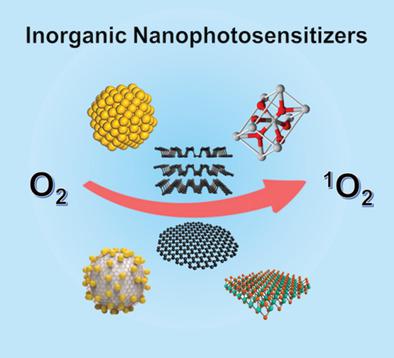Our official English website, www.x-mol.net, welcomes your feedback! (Note: you will need to create a separate account there.)
Inorganic Nanomaterials with Intrinsic Singlet Oxygen Generation for Photodynamic Therapy
Advanced Science ( IF 15.1 ) Pub Date : 2021-09-24 , DOI: 10.1002/advs.202102587 Muhammad Rizwan Younis 1, 2, 3 , Gang He 1 , Junle Qu 2 , Jing Lin 1 , Peng Huang 1 , Xing-Hua Xia 3
Advanced Science ( IF 15.1 ) Pub Date : 2021-09-24 , DOI: 10.1002/advs.202102587 Muhammad Rizwan Younis 1, 2, 3 , Gang He 1 , Junle Qu 2 , Jing Lin 1 , Peng Huang 1 , Xing-Hua Xia 3
Affiliation

|
Inorganic nanomaterials with intrinsic singlet oxygen (1O2) generation capacity, are emerged yet dynamically developing materials as nano-photosensitizers (NPSs) for photodynamic therapy (PDT). Compared to previously reported nanomaterials that have been used as either carriers to load organic PSs or energy donors to excite the attached organic PSs through a Foster resonance energy transfer process, these NPSs possess intrinsic 1O2 generation capacity with extremely high 1O2 quantum yield (e.g., 1.56, 1.3, 1.26, and 1.09) than any classical organic PS reported to date, and thus are facilitating to make a revolution in PDT. In this review, the recent advances in the development of various inorganic nanomaterials as NPSs, including metal-based (gold, silver, and tungsten), metal oxide-based (titanium dioxide, tungsten oxide, and bismuth oxyhalide), metal sulfide-based (copper and molybdenum sulfide), carbon-based (graphene, fullerene, and graphitic carbon nitride), phosphorus-based, and others (hybrids and MXenes-based NPSs) are summarized, with an emphasis on the design principle and 1O2 generation mechanism, and the photodynamic therapeutic performance against different types of cancers. Finally, the current challenges and an outlook of future research are also discussed. This review may provide a comprehensive account capable of explaining recent progress as well as future research of this emerging paradigm.
中文翻译:

用于光动力治疗的具有内在单线态氧生成的无机纳米材料
具有内在单线态氧(1 O 2)生成能力的无机纳米材料作为用于光动力疗法(PDT)的纳米光敏剂(NPS)而出现并正在动态开发材料。与之前报道的纳米材料(用作负载有机PS的载体或通过福斯特共振能量转移过程激发附着的有机PS的能量供体)相比,这些NPS具有内在的1 O 2生成能力和极高的1 O 2量子产率(例如,1.56、1.3、1.26 和 1.09)比迄今为止报道的任何经典有机 PS 都要高,因此正在促进 PDT 的革命。本文综述了各种无机纳米材料作为NPS的最新进展,包括金属基(金、银和钨)、金属氧化物基(二氧化钛、氧化钨和卤氧化铋)、金属硫化物基总结了NPS(硫化铜和硫化钼)、碳基(石墨烯、富勒烯和石墨氮化碳)、磷基和其他(混合材料和MXenes基NPS),重点介绍了设计原理和1 O 2生成机制,以及针对不同类型癌症的光动力治疗性能。最后,还讨论了当前的挑战和未来研究的展望。这篇综述可能会提供一个全面的说明,能够解释这一新兴范式的最新进展以及未来的研究。
更新日期:2021-11-04
中文翻译:

用于光动力治疗的具有内在单线态氧生成的无机纳米材料
具有内在单线态氧(1 O 2)生成能力的无机纳米材料作为用于光动力疗法(PDT)的纳米光敏剂(NPS)而出现并正在动态开发材料。与之前报道的纳米材料(用作负载有机PS的载体或通过福斯特共振能量转移过程激发附着的有机PS的能量供体)相比,这些NPS具有内在的1 O 2生成能力和极高的1 O 2量子产率(例如,1.56、1.3、1.26 和 1.09)比迄今为止报道的任何经典有机 PS 都要高,因此正在促进 PDT 的革命。本文综述了各种无机纳米材料作为NPS的最新进展,包括金属基(金、银和钨)、金属氧化物基(二氧化钛、氧化钨和卤氧化铋)、金属硫化物基总结了NPS(硫化铜和硫化钼)、碳基(石墨烯、富勒烯和石墨氮化碳)、磷基和其他(混合材料和MXenes基NPS),重点介绍了设计原理和1 O 2生成机制,以及针对不同类型癌症的光动力治疗性能。最后,还讨论了当前的挑战和未来研究的展望。这篇综述可能会提供一个全面的说明,能够解释这一新兴范式的最新进展以及未来的研究。



























 京公网安备 11010802027423号
京公网安备 11010802027423号